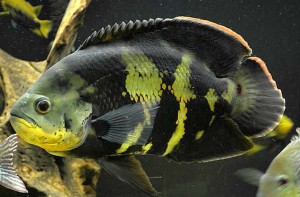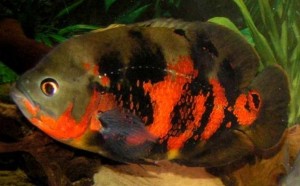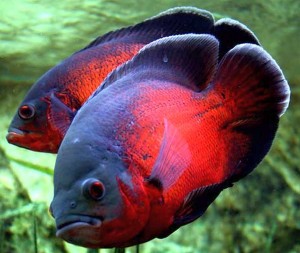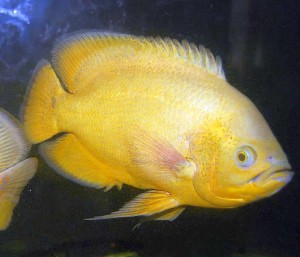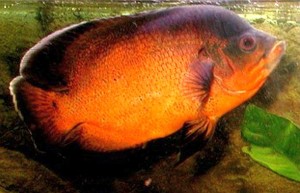The Oscar (Astronotus ocellatus) is a popular South American cichlid species that is also known to tropical fish keeping enthusiasts as the Tiger Oscar, Marble Cichlid and Velvet Cichlid.
Astronotus ocellatus is native to Brazil, Colombia, Ecuador, French Guiana, Peru, and occurs in the Amazon River basin, along the Amazonas, Içá, Negro, Solimões, and Ucayali River systems, as well as in the Approuague and Oyapock River drainages.
Feral populations occur in northern Australia, China, and southern Florida where they were introduced as a byproduct of the tropical fish keeping hobby. Fortunately, its intolerance to cooler water temperatures (less than 55.22 °F) has limited its distribution to more tropical areas.
In their natural environment, Oscars prefer slower moving, white water areas where they stage around submerged tree branches and other cover to prey on small fish, worms, insects, crayfish and other crustaceans.
The Oscar is a popular aquarium species in the United States but in their natural habitat they are commonly harvested as a food fish and are frequently found in local fish markets.
Wild caught Oscars are darkly colored with yellow ringed spots or ocelli on the dorsal fin and caudal peduncle. They are able to quickly change their coloration when confronted with aggressive conspecifics.
The eye spots are believed to minimize the amount of fin nipping caused by predators like piranha (Serrasalmus spp.) that occur with them in their natural range.
Juveniles are striped with white and orange wavy bands, and have spots on their heads.
Several varieties of Astronotus ocellatus have been developed by breeders over the years for the aquarium hobby. These include the Red Tiger Oscar which has marbled patches of red pigmentation, the Red Oscar which has mainly red coloration on its flanks, Albino Oscars which are all white, Zebra Oscars which are black and white with gray shading, and a recently developed long finned variety called the Veil Tail Oscar.
The Tiger Oscar has a blue black body with a beautiful orange red pattern and a brightly colored eye spot. The Yellow Oscar is a relatively new variety to the trade that has a minimal eye spot.
Differentiating sexes is difficult but during spawning the females develop genital papilla and are slightly plumper in appearance.
Oscars require a large lightly planted aquarium of at least 70 gallons with a deep sand or fine gravel substrate, a few large rocks, and some driftwood
for them to hide among. Because they are substrate “diggers”, its a good idea to either use floating plants in the tank or bury some potted plants into the substrate, covered with a few small rocks to hold them down.
Oscars are not as territorial as other cichlids, however they are predaceous carnivores and will eat anything large enough for them to fit into their mouths. As juveniles, they cluster together for protection and as they grow into adulthood, they will form into pairs, make a nuclear family, and become generally peaceful in nature.
When keeping Oscars in an aquarium environment, it is best to keep either one specimen in a tank, or at least six specimens in a tank to minimize aggressiveness. Keep in mind that as the fish grow, each specimen will require at least 70 to 80 gallons of water to thrive. This means that if you purchase 6 Oscars, you will eventually need at least a 500 gallon tank to keep them happy and safe from each other.
Oscars can be housed in a large community aquarium with large Plecostomus, Texas Cichlids, Jack Dempseys, Salvini, White Tip Sharks, Clown Knifefish, Tinfoil Barbs, Black Barred Tiger Fish, groups of large Clown Loaches, and even some of the larger freshwater eels like the Snowflake Eel.
Oscars are relatively easy to breed in an aquarium environment however they need a large tank of at least 100 gallon capacity. They will spawn in clean clear water that is between 79 and 86°F. The hardness of the water is irrelevant as long as the water quality is pristine.
When ready to spawn, the pair will carefully clean off an area on a rock where the female will deposit between 1,000 to 2.000 opaque eggs. The eggs turn transparent within 24 hours and will hatch shortly thereafter. The parents will guard and care for the fry by digging shallow pits in the substrate where they are herded. When the fry are free swimming, they can be fed baby brine shrimp, Cyclops, daphnia and later, crushed flake food. There is usually no need to separate the parents from the fry.
Oscar are predatory carnivores that are hearty eaters in an aquarium environment. They will eat a variety of fresh, frozen and freeze dried meaty foods such as small fish, bloodworms, tubifex
, earthworms, small shrimp, and ocean plankton. They will eagerly eat Cichlid pellets and large size flake foods but should not be fed beef heart, mammal or poultry meats, goldfish, or rosy red feeder minnows.
Oscars of all varieties are usually available for purchase when they are 1 1/2″ to 3 1/2″ or larger in size.
Minimum Tank Size: 70 gallons
Care Level: Easy
Temperament: Semi Aggressive
Aquarium Hardiness: Hardy
Water Conditions: 72-77° F, KH 5-19, pH 6.0-8.0
Max. Size: 1′
Color Form: Black, Orange, Red
Diet: Carnivore
Compatibility: Single species tank
Origin: Amazon, South America
Family: Cichlidae
Lifespan: 10-15 years
Aquarist Experience Level: Beginner


